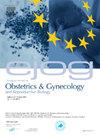硬膜外分娩镇痛对分娩期间胃排空的影响:一项前瞻性对照研究
IF 2.1
4区 医学
Q2 OBSTETRICS & GYNECOLOGY
European journal of obstetrics, gynecology, and reproductive biology
Pub Date : 2025-03-07
DOI:10.1016/j.ejogrb.2025.03.003
引用次数: 0
摘要
背景硬膜外镇痛经常用于减轻分娩疼痛,分娩期间的饮食管理至关重要。因此,本研究探讨分娩时硬膜外镇痛对产妇胃排空的影响。方法将70例足月产妇分为硬膜外镇痛组(LA, n = 35)和非硬膜外镇痛组(NA, n = 35)。在T0时采用b超评估空腹胃窦横断面积(CSA0)。然后两组都喝了300克小米粥(600千焦)。餐后超声于60 min (CSA1, T1)、90 min (CSA2, T2)和120 min (CSA3, T3)测量csa。记录两组患者在这四个时间点的疼痛评分,并记录胃排空时间。结果NA组CSA明显大于LA组(CAS1:11.4±0.8 vs 10.2±0.6;CAS2:9.3±0.6 vs 8.3±0.5;CAS3:7.4±0.5 vs 6.5±0.4;p = 0.00)。LA组胃排空时间较NA组短(197.5±27.2∶220.9±29.2,P = 0.00)。结论硬膜外镇痛有助于分娩时胃排空。因此,分娩时硬膜外镇痛不会对产妇的饮食偏好产生不利影响。简单的语言总结。在分娩过程中,妇女经常忍受剧烈的疼痛,这促使人们广泛使用硬膜外镇痛来缓解疼痛。然而,在分娩过程中选择硬膜外镇痛的妇女的饮食考虑日益引起人们的注意。许多研究已经证实,适度的食物消费可以为女性提供能量,而不会造成任何有害影响。我们的研究发现,硬膜外镇痛可以加速分娩过程中的胃排空。以往的临床经验提示,患者在麻醉前后不应进食,但本研究显示,即使产妇选择硬膜外分娩镇痛,在整个分娩过程中仍可继续摄入一定量的半固体食物以提供能量,而无需担心呕吐风险增加。本文章由计算机程序翻译,如有差异,请以英文原文为准。
Effect of epidural labour analgesia on gastric emptying during labour: A prospective controlled study
Background
Epidural analgesia is frequently used to alleviate labour pain, and dietary management during labour is of crucial importance. Therefore, this study investigates the impact of epidural analgesia for labour on gastric emptying in parturient women.
Methods
A total of 70 full-term parturient women were recruited and divided into two groups: the epidural analgesia group (LA, n = 35) and the non-epidural analgesia group (NA, n = 35). Fasting gastric antrum cross-sectional area (CSA0) was assessed using B-mode ultrasonography at T0. Both groups then consumed 300 g of millet porridge (600KJ). Post-meal, CSAs were measured at 60 min (CSA1, T1), 90 min (CSA2, T2), and 120 min (CSA3, T3) using ultrasonography. Pain scores were recorded for both groups at these four time points, and gastric emptying time was noted.
Results
The CSA in the NA group were larger than those in the LA group (CAS1:11.4 ± 0.8 vs 10.2 ± 0.6;CAS2:9.3 ± 0.6 vs 8.3 ± 0.5,CAS3:7.4 ± 0.5 vs 6.5 ± 0.4; P = 0.00). The gastric emptying time in the LA group was shorter than that in the NA group (197.5 ± 27.2 vs. 220.9 ± 29.2, P = 0.00).
Conclusions
Epidural analgesia facilitates gastric emptying during labour. Therefore, the administration of epidural analgesia during labour does not adversely affect maternal dietary preferences.
Plain language summary.
During labour, women often endure severe pain, prompting the widespread use of epidural analgesia for pain relief. However, the dietary considerations for women opting for epidural analgesia during labour have increasingly garnered attention. Numerous studies have now corroborated that moderate food consumption can supply energy to women without posing any detrimental effects. Our research has observed that epidural analgesia can expedite gastric emptying during labour. Previous clinical experience suggested that patients should not eat before or after anesthesia, but this study shows that even if a parturient opts for epidural labor analgesia, she can still continue to consume a certain amount of semi-solid food to provide energy throughout the labor process, without needing to worry about an increased risk of vomiting.
求助全文
通过发布文献求助,成功后即可免费获取论文全文。
去求助
来源期刊
CiteScore
4.60
自引率
3.80%
发文量
898
审稿时长
8.3 weeks
期刊介绍:
The European Journal of Obstetrics & Gynecology and Reproductive Biology is the leading general clinical journal covering the continent. It publishes peer reviewed original research articles, as well as a wide range of news, book reviews, biographical, historical and educational articles and a lively correspondence section. Fields covered include obstetrics, prenatal diagnosis, maternal-fetal medicine, perinatology, general gynecology, gynecologic oncology, uro-gynecology, reproductive medicine, infertility, reproductive endocrinology, sexual medicine and reproductive ethics. The European Journal of Obstetrics & Gynecology and Reproductive Biology provides a forum for scientific and clinical professional communication in obstetrics and gynecology throughout Europe and the world.

 求助内容:
求助内容: 应助结果提醒方式:
应助结果提醒方式:


